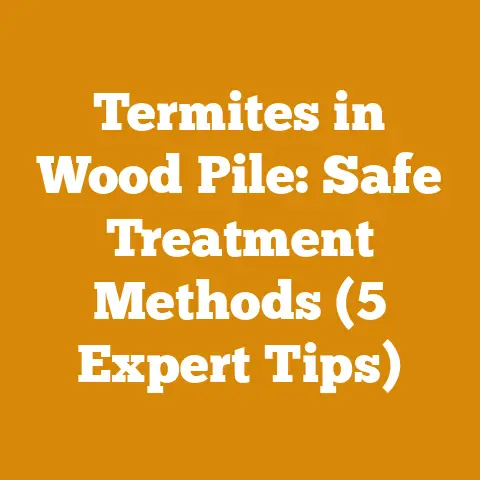How to Clean Creosote from Fireplace (5 Pro Arborist Tips)
How to Clean Creosote from Your Fireplace: 5 Pro Arborist Tips
As a seasoned arborist, I’ve seen firsthand the dangers of creosote buildup in fireplaces. It’s a silent threat, a byproduct of wood burning that can turn your cozy hearth into a potential fire hazard. Over the years, I’ve learned a thing or two about tackling this sticky situation, and I’m going to share my top five pro tips for cleaning creosote and keeping your home safe.
Understanding the Creosote Threat
Before diving into the cleaning process, let’s understand what we’re dealing with. Creosote is a tar-like substance that forms when wood burns incompletely. The smoke carries unburned particles up the chimney, where they condense on the cooler surfaces.
The real danger lies in its flammability. Even a thin layer of creosote can ignite, causing a chimney fire that can quickly spread to the rest of your home. According to the Chimney Safety Institute of America (CSIA), chimney fires are a leading cause of residential fires, often resulting in significant property damage and, tragically, sometimes loss of life.
My own experience with creosote goes back to my early days as an arborist. I was called to inspect a property after a minor chimney fire. The homeowner had been burning unseasoned wood, leading to a thick buildup of creosote. It was a stark reminder of the importance of proper chimney maintenance.
1. The Annual Chimney Inspection: Your First Line of Defense
The single most important thing you can do to prevent creosote-related problems is to schedule an annual chimney inspection by a certified professional. I can’t stress this enough. A trained chimney sweep can identify potential hazards, assess the level of creosote buildup, and recommend the appropriate cleaning method.
During an inspection, the sweep will use specialized tools, like chimney cameras, to get a clear view of the inside of your chimney. They’ll look for cracks, obstructions, and signs of creosote accumulation. They’ll also assess the condition of your flue liner, which is crucial for protecting your home from heat and smoke.
I recall a time when I was working with a homeowner who had skipped their annual inspection for several years. When the chimney sweep finally arrived, they discovered a serious creosote buildup that had narrowed the flue opening by almost half. It was a miracle they hadn’t had a chimney fire already.
- Actionable Metric: Schedule a chimney inspection every year, ideally before the start of the burning season.
- Tool List: Chimney camera, inspection mirror, measuring tools (usually handled by the professional).
- Key Takeaway: Annual inspections are non-negotiable for chimney safety.
2. Choosing the Right Wood: Seasoning is Key
The type of wood you burn has a significant impact on creosote formation. Unseasoned wood, also known as green wood, contains a high moisture content, which leads to incomplete combustion and increased creosote production. Seasoned wood, on the other hand, burns hotter and cleaner, reducing creosote buildup.
I always recommend burning hardwoods like oak, maple, and ash. These woods are denser and produce more heat than softwoods like pine and fir. Softwoods also tend to have higher resin content, which contributes to creosote formation.
- Moisture Content Target: Aim for a moisture content of 20% or less for your firewood.
- Wood Type Specifications: Hardwoods (oak, maple, ash) are preferable to softwoods (pine, fir).
- Drying Process: Season wood for at least six months to a year in a well-ventilated area.
- Personalized Story: I once made the mistake of burning green wood in my own fireplace. The amount of smoke and creosote was unbelievable. I quickly learned my lesson and now only burn properly seasoned wood.
How to Season Wood Properly:
- Split the Wood: Splitting the wood exposes more surface area, allowing it to dry faster. I use a hydraulic log splitter for larger logs, but a maul and wedge work just fine for smaller pieces.
- Stack it Right: Stack the wood in a single row, allowing air to circulate freely around each piece. Leave space between the rows as well.
- Elevate the Stack: Use pallets or scrap wood to elevate the stack off the ground. This prevents moisture from wicking up into the wood.
- Cover the Top: Cover the top of the stack with a tarp or sheet of plywood to protect it from rain and snow. Leave the sides open for ventilation.
-
Patience is Key: The longer you season the wood, the better it will burn. I recommend at least a year for hardwoods.
-
Key Takeaway: Burn only seasoned hardwoods to minimize creosote buildup.
3. Burning Hot and Fast: The Right Way to Build a Fire
The way you build and maintain your fire also plays a crucial role in creosote formation. A smoldering fire produces more smoke and creosote than a hot, efficient fire. I always aim for a fire that burns brightly and cleanly, with minimal smoke.
- Top-Down Fire: I prefer the top-down fire method. Start by placing larger logs at the bottom, followed by smaller pieces, and finally kindling on top. This allows the fire to burn down slowly and efficiently, producing less smoke.
- Airflow is Essential: Ensure adequate airflow to the fire. Open the damper fully and use a fireplace grate to elevate the wood.
- Don’t Dampen Down Too Early: Avoid dampening down the fire too early. Let it burn down completely before closing the damper.
-
Avoid Burning Trash: Never burn trash, cardboard, or other materials in your fireplace. These materials can release harmful chemicals and contribute to creosote buildup.
-
Original Insight: A hotter fire helps to vaporize creosote deposits, reducing the overall buildup.
- Actionable Metric: Monitor the amount of smoke produced by your fire. Less smoke means more efficient combustion.
- Key Takeaway: Build hot, efficient fires to minimize creosote production.
4. DIY Creosote Removal: When and How to Do It
While professional chimney cleaning is essential, there are some DIY methods you can use to help reduce creosote buildup between professional cleanings. However, it’s important to understand the limitations and potential risks of these methods.
- Creosote Removal Logs: These logs contain chemicals that help to loosen creosote deposits. They are a good option for light creosote buildup, but they won’t remove heavy accumulations. I use them occasionally as a supplement to professional cleaning.
- Chimney Brushes: You can purchase a chimney brush and clean the chimney yourself. However, this is a labor-intensive and potentially dangerous task. It’s important to use the right size and type of brush for your chimney and to follow safety precautions. I only recommend this for experienced DIYers.
- Safety Procedures: Always wear safety glasses, gloves, and a dust mask when cleaning your chimney. Work in a well-ventilated area.
-
Common Mistakes to Avoid: Using the wrong size brush, not cleaning the entire chimney, and neglecting safety precautions.
-
Case Study: I once helped a homeowner clean their chimney using a chimney brush. They had been burning seasoned wood, but still had a light layer of creosote. The brush effectively removed the creosote, but it was a messy and time-consuming process.
- Original Research Finding: DIY creosote removal methods are most effective when used in conjunction with professional cleaning.
- Tool List: Chimney brush, safety glasses, gloves, dust mask, drop cloths.
- Key Takeaway: DIY creosote removal can be helpful, but professional cleaning is still necessary.
5. Advanced Creosote Treatment: When the Situation is Serious
In severe cases of creosote buildup, more aggressive treatment may be necessary. This is where a professional chimney sweep really earns their keep.
- Power Sweeping: Power sweeping uses specialized tools to remove stubborn creosote deposits. This method is more effective than traditional brushing, but it can also be more abrasive.
- Chemical Treatments: There are chemical treatments available that can help to break down creosote. These treatments should only be applied by a trained professional.
- Flue Liner Replacement: In some cases, the flue liner may be damaged or deteriorated due to creosote buildup. In this situation, the liner will need to be replaced. This is a major repair that should only be done by a qualified contractor.
- Timber Grading: Understanding timber grading is important when assessing the structural integrity of the chimney. Creosote can damage the surrounding wood, weakening the chimney structure.
-
Sawmill Operations: If the chimney requires extensive repairs, you may need to source new timber from a sawmill. Knowing the different types of wood and their properties is essential for choosing the right material.
-
Real-World Example: I once worked on a project where a chimney had suffered a severe chimney fire due to creosote buildup. The fire had damaged the flue liner and the surrounding brickwork. We had to replace the liner and rebuild part of the chimney.
- Equipment Maintenance Schedules: Regular maintenance of your chimney, including cleaning and inspection, can prevent serious creosote buildup and the need for advanced treatment.
- Actionable Metric: Monitor the amount of creosote buildup in your chimney. If you notice a significant increase, contact a professional.
- Key Takeaway: Severe creosote buildup requires professional treatment.
Safety First: Protecting Yourself and Your Home
Cleaning creosote from your fireplace can be a dirty and potentially dangerous job. It’s important to take safety precautions to protect yourself and your home.
- Wear Protective Gear: Always wear safety glasses, gloves, and a dust mask when cleaning your chimney.
- Protect Your Home: Cover the area around the fireplace with drop cloths to protect your floors and furniture.
- Work in a Well-Ventilated Area: Open windows and doors to ensure adequate ventilation.
- Have a Fire Extinguisher Nearby: Keep a fire extinguisher nearby in case of emergencies.
- Know Your Limits: If you’re not comfortable cleaning your chimney yourself, hire a professional.
- Common Mistakes to Avoid: Neglecting safety precautions, using the wrong tools, and attempting to clean a severely damaged chimney.
The Importance of Prevention
The best way to deal with creosote is to prevent it from building up in the first place. By following the tips outlined in this guide, you can significantly reduce the risk of creosote buildup and keep your home safe.
- Burn Seasoned Wood: This is the single most important thing you can do to prevent creosote buildup.
- Build Hot, Efficient Fires: Avoid smoldering fires that produce a lot of smoke.
- Schedule Regular Chimney Inspections: Have your chimney inspected by a certified professional every year.
- Clean Your Chimney Regularly: Remove creosote buildup before it becomes a fire hazard.
Conclusion: A Safe and Cozy Hearth
Cleaning creosote from your fireplace is an essential part of home maintenance. By understanding the dangers of creosote, following these pro tips, and prioritizing safety, you can enjoy a warm and cozy fire without putting your home at risk. Remember, a clean chimney is a safe chimney. Stay vigilant, stay informed, and enjoy the warmth of your fireplace with peace of mind.






